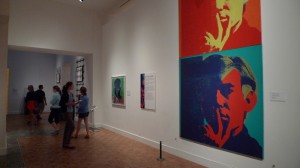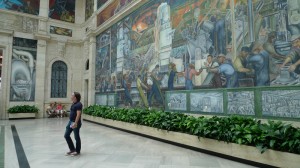Far from bankrupt: Michigan art museums thrive despite economic woes
To hear John Henry, director of the Flint Institute of Arts, tell it, there once existed a near-magical time in that city’s history, when its blue-collar roots lived in harmony with a yearning for beauty and creativity somewhere off the assembly line.
That was the era when Charles Stewart Mott, the city’s two-time mayor and philanthropist, donated acreage for a cultural center, where Flint residents could find music, theater, science, history, art and education on one campus. It was the birthplace of continuing education, born of the idea that line workers should be able to shake off the mental torpor of their jobs with, say, a ceramics class.
“There were ceramics classes that started at midnight,” said Henry, who lives today in a very different Flint. The downsizing of the auto industry sapped its strength and drained its population, but its cultural center – and its art museum – remains.
“No city our size in the country has this,” said Henry of the eight institutions that make up the center. “We’re doing collectively $12-13 million a year in programming, much of which is free or subsidized.”
Which may go to show that even in a blue-collar city in a blue-collar state, there is still something special about art – even as that art is potentially imperiled by cities’ fiscal implosions.
The Detroit Institute of Arts is gathering most of the media attention paid to the state’s cultural sector these days as the DIA works furiously to protect its assets from being swept up in Detroit’s municipal bankruptcy proceedings. The foreboding publicity has been good for business this summer. DIA Director Graham Beal notes that attendance was 10,000 in a recent summer week, compared to a more typical 3,000-4,000, and just 2,000 two years ago. Whether visitors are coming because the museum is in the news or because they fear its collection is in peril doesn’t really matter to Beal.
“We’re hopping,” he said. “It’s the power of free and the power of advertising.”
Since a 2012 tax millage gave the DIA a $23 million annual funding stream, admission has been free to residents of Wayne, Oakland and Macomb counties, and the museum has seen attendance rise by 48 percent, to 594,000 in the just-completed fiscal year. Friday-night live music programming and Sunday family events draw crowds, and a new “living room” space with wifi and food is drawing visitors to use the museum the way they might a Starbucks.
Michigan’s other art museums appear to have capably weathered the recession. In Kalamazoo, director Jim Bridenstine vowed that no one would lose a job or health insurance because of the drop in contributions that came with the economic downturn. Everyone took a salary cut – Bridenstine settled on the formula of cutting all salaries by a percentage determined by the first digit in an employee’s annual salary – but now they’re coming back. In Grand Rapids, a new building opening in 2007, and Art Prize’s debut in 2009, kept bodies moving through the front doors. Even Muskegon, whose museum director describes it as “a scrappy town on its best day,” is finishing an 18-month endowment drive and its staff expects to reach its $7.5 million goal easily.
The Cultural Data Project, which collects financial and other information about the arts and culture sector in 12 states around the country, puts Michigan’s 427 member organizations’ earned revenue at over $417 million, and attendance at all those venues at over 15 million. While there is no separate data for the art-museum sector, their attribute the institutions’ health to a variety of factors, but mostly strong community support and respect for their deep roots.
The Muskegon Museum of Art, for instance, opened in 1912, “the first building in a city of this size built specifically to hold art,” said Judith Hayner, its director for a decade. Endowed by lumber baron Charles Hackley via the local public schools, the museum has seen the end of the lumbering era, the rise and fall of industrialization and still survives, thanks to a dedicated core of supporters and what Hayner calls aggressive programming.
“We don’t have incidental foot traffic, so we have to create and draw people to us,” she said. The museum puts on “about 15” changing exhibits a year, an ambitious schedule that gives residents a reason to stop by more than once or twice a year. With attendance of about 30,000 annually, “in a county of 171,000 people, I don’t think that’s bad,” Hayner said.
Across the state in East Lansing, Michael Rush, director of the newly opened Eli and Edythe Broad Art Museum is singing a similar tune. The contemporary-art institution will conclude its first year in a striking new building on the Michigan State campus this fall. An “optimistic” annual attendance goal of 100,000 was reached in nine months.
“We’ve had visitors from every state in the union and 75 countries,” Rush said. The museum has seen $90,000 in facility rentals, and even the café store is making money.
In Kalamazoo, Bridenstine credits the museum’s associated art school with keeping foot traffic up and programming that strives to reach a variety of visitors. And even its location in a mid-size city doesn’t hurt. The DIA’s Beal calls the Kalamazoo Institute of Arts the second-best museum in the state, after his own.
“The best compliments I get are from colleagues,” said Bridenstine. “They come expecting something nice, but they’re really surprised by how nice.”
If there is a subset of Michigan museums that aren't doing so well, it would include the Art Center of Battle Creek, which strives to be both a destination for art lovers and a community school for artists. Making it on a $275,000 budget, it has one full-time staff member – executive director Linda Holderbaum. The art center "gets by," but offers more "cultural" exhibits than its larger peers; it's ready to open the doors on a show devoted to Star Wars.
"One of my board members wondered why we were showing this," said Holderbaum. "It's a valid question. My answer is that it changed the entire film industry. And if you told George Lucas it wasn’t art, he’d strangle you."
The art center serves a different niche, Holderbaum admits, due to its smaller size. Serious art lovers would be more likely to travel to Kalamazoo or another city.
In the state's largest city, none of the art-world specialists expect the DIA to be hollowed out by Detroit’s fiscal problems, although the perceived threat is being taken seriously. Muskegon’s museum, for example, has always functioned as a part of the Muskegon Public Schools, whose board of education erected the building and organized the collection in the early 20th century.
Now in its 102nd year, with its museum endowment flush, the Muskegon schools are operating in a deficit, which raises the specter of emergency management in the future and the potential for a similar threat to its collection.
Although the museum has a separate ownership board, it is taking no chances. The institution is going forward with plans to separate entirely from the schools in 2014.
See what new members are saying about why they donated to Bridge Michigan:
- “In order for this information to be accurate and unbiased it must be underwritten by its readers, not by special interests.” - Larry S.
- “Not many other media sources report on the topics Bridge does.” - Susan B.
- “Your journalism is outstanding and rare these days.” - Mark S.
If you want to ensure the future of nonpartisan, nonprofit Michigan journalism, please become a member today. You, too, will be asked why you donated and maybe we'll feature your quote next time!


 An Andy Warhol self-portrait dominates a gallery at the Detroit Institute of Arts, which has seen its attendance spike since media publicized potential threats to the DIA collection from the city's bankruptcy filing. (Bridge photo by Nancy Derringer)
An Andy Warhol self-portrait dominates a gallery at the Detroit Institute of Arts, which has seen its attendance spike since media publicized potential threats to the DIA collection from the city's bankruptcy filing. (Bridge photo by Nancy Derringer) Diego Rivera's "Detroit Industry" murals are one of the most popular draws for the Detroit Institute of Arts, where they dominate a four-sided courtyard space on the museum's main floor. (Bridge photo by Nancy Derringer)
Diego Rivera's "Detroit Industry" murals are one of the most popular draws for the Detroit Institute of Arts, where they dominate a four-sided courtyard space on the museum's main floor. (Bridge photo by Nancy Derringer)